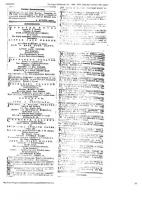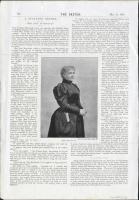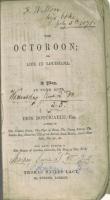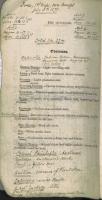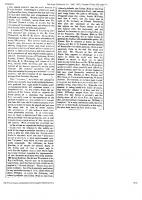Artifacts
Item set
Title
Artifacts
Items
21 items
-
"The Octoroon" review by The Argus Melbourne
This "Argus" article reviews Madame Marie Duret, taking the role of Zoe Peyton for the opening night of "The Octoroon," in Melbourne, Australia. Thus, "The Octoroon" was performed on the colonial stages of Australia a full ten months before it was staged in London. This review provided a detailed description of the plot, and noted the play culminated in the death of Zoe, as it had in the original American version. In America, racist beliefs led to hundreds of years of enslavement of African captives and their descendants; in Australia, such attitudes resulted more specifically in systematic genocide of the native population--though certainly forms of slavery existed. -
Advertisement for Performance at Princess Theatre in Melbourne 1861
The Octoroon was actually performed on the colonial stages of Australia a full ten months before it was staged in London. According to the Melbourne Argus, the first performance of The Octoroon in Australia, advertised as the "first time in the colonies of Bourcicault's [sic] great sensation play, was to take place on January 7, 1861, and featured British actress Madame Marie Duret as Zoe. Little is known about Marie Duret or where she obtained a copy of the script for The Octoroon, which had been printed, but not published in America. -
Agnes Robertson stars in "The Phantom" by Dion Boucicault at Princess's Theatre, London, under the management of Charles Kean
The premiere of “The Phantom” on June 7 1852, is one of the earliest performances of a play by Dion Boucicault in which Agnes Robertson (then aged 19) starred. -
Article "Spirit of the Times" featuring a letter from Agnes Robertson about receiving death threats for the performance as Zoe
Almost as soon as "The Octoroon" opened in New York, both Boucicault and Robertson claimed that Robertson had received death threats for appearing on stage as Zoe and, as a result, decided to withdraw from their contract at the Winter Garden Theatre. In a letter published in the Spirit of the Times, Robertson alleged she had "received letters from many families in this city urging the withdrawal or alteration of the play," and she had been "intimidated by letters threatening us with violence." In portraying Zoe, Robertson claimed that she had been "unconsciously made the instrument to wound the feelings of one part of the public to gratify the other." Robertson avowed that she did not want "to make money out of a political excitement--especially on any subject such as slavery, and at such a moment as this. The Octoroon was not intended to succeed on such merits." Apparently it was Robertson's sympathetic portrayal of an enslaved mixed-race woman that inflamed audiences. The threat of actual violence against a racialized and gendered figure on stage, portraying one on the auctionplatform, was a material fact in both the plot and production history of The Octoroon. -
Article discussing canceled performance of The Octoroon after Lincoln's assassination
On the evening of April 14, 1865, at a special performance of the comedy, Our American Cousin, by English playwright Tom Taylor, starring English actress and stage manager Laura Keene, President Abraham Lincoln was shot. And killed by John Wilkes Booth whose family were a major dynasty of American actors and whose brother was famous actor Edwin Booth. The playbills for Our American Cousin had included a notice that the next play to be staged at Ford’s was to be Dion Boucicault’s The Octoroon and by 15th April, a large poster appeared outside the theater advertising the forthcoming performance. That performance did not take place and the theater was closed from 14th April until the execution of Lincoln’s assassin, John Wilkes Booth, in July 1865. Ford had decided to reopen on July 10 also with The Octoroon but again the show was cancelled as a result of threats against both the stage manager and the theater. This article, from the New York Herald, declared the attempt to reopen "an attempt to coin the blood of the great man." Later that year, Ford’s theatre was repurposed as a federal government building and it was not until 1968 that it would again function as a theater. -
Article, Agnes Robertson, 'Biographical Sketch,' The Sketch Newspaper
In this interview ("A Splendid Record: Mrs Dion Boucicault," The Sketch, May 16, 1894, 146), Robertson recounted that it was her appearance in the slave auction scene of The Octoroon that had attracted the most virulent attention when the play had been performed in New York. She claimed that she had been "solemnly warned that if I attempted to play this auction scene I should be shot as I stood on the table to be sold." Robertson also stated that she did not “sympathise with the aims of writers who wish to use the stage as a moral dissecting-room.” Yet Robertson also cited as “most thrilling” her appearance as Zoe. -
Britannia Prompt Book
"At the University of Kent, in Canterbury, England, we have explored an Octoroon promptbook belonging to Frederick Wilton, an actor and stage manager of the Britannia Theatre in London's East End from 1846 to 1875 (""Octoroon: A Collection of Parts,"" Promptbook at Templeman Library University of Kent). Wilton performed the role of Salem Scudder in an 1871 production of the play. Two of the ‘sides’ or character part script promptbooks are from members of Britannia Theatre company, Frederick Wilton, stage manager {“Octoroon ‘Scudder” book in Kent Library, but Wilton actually played Sunnyside in 1871 according to ammendations to cast notes inside}; and Mrs. S[am] Lane’s “Octoroon “Pete” part, inscribed “Mrs. Sarah Lane, Britannia Theatre, Hoxton, July 6 1871.” [Sarah Lane was widow of Sam Lane, and became manager of the Britannia]. These were written on Boucicault, The Octoroon, London: Thomas Hailes Lacy, 1861) edition of Octoroon and contain handwritten notations for at least 3 different possible endings.} -
Britannia Prompt Book Title Page
The Britannia Promptbooks mention several performances of The Octoroon (in addition to bearing the inscription from F. Wilton “hys Boke,”) during the management of Sarah Lane, including Wednesday 2 June 1880. The performance lasted “2.5.” Another performance was noted for Monday June 21, 1880, with the same running time. Additionally, an “average” performance time of “2.0” is noted, suggesting that performances of 2.5 hours included a fifth act, which is supported by the handwritten notations in the promptbook, which restore the original ending of the play as it had been performed in New York in 1859, with the heroine committing suicide. -
Britannia Prompt Book, Act 1, Page 1
One of the important resources for this Octoroon project is the “Scudder” part of the Octoroon promptbook at the University of Kent's Templeman Library. The first page in Act I of this artifact features handwritten information about several performances in the Britannia theatre and their running times. These variation is running time tell us about the different types of performances that may have featured on those nights, which has helped us to understand that even though Boucicault reduced the running time in early 1862, subsequent productions of The Octoroon reverted back to the longer, five act versions, which ended either with the heroine’s death or with her happy union with her lover. -
Britannia Prompt Book, Costume Page
The Octoroon promptbook belonging to Frederick Wilton is held at the Univeity of Kent’s Templeman library. Wilton's promptbook is playfully inscribed, "F. Wilton hys boke July 5 1871," and it consists a copy of the published four-act script of The Octoroon, (in which the heroine neither kills herself, nor marries her white suitor, George, but appears silently in his arms in a concluding tableau), into which numerous pages of handwritten annotations are added. In this printed four-act version, the printed pages of the script conclude with stage directions that merely state that "George enters, bearing Zoe in his arms--all the characters rush on." Characters watch as the steamboat Magnolia explodes onstage, along with this spectacular stage effect, they form a "grand tableaux," that is followed by the "Curtain." -
Illustrated London News newspaper article and illustration about the play in England
On July 18, 1860, the Boucicaults returned to England and on 18 November 1861, almost two years after its New York debut, the Boucicaults staged The Octoroon in London for the first time. For several weeks the Boucicaults performed The Octoroon as it was staged in America, ending with the character Zoe committing suicide. This article, from The London Illustrated News (30 November 1861) had chosen to illustrate the “sensation scene” of Zoe being sold as a slave at auction, and the reviewer commented “if it had been morally possible for the author to have given a happier ending to his drama it would have been more immediately popular.” In fact, London audiences vocally expressed their disapproval at the protracted and graphic death of the heroine. Letters were written to Boucicault, and published in the British press, imploring him to re-write the ending and allow Zoe to survive and marry her white suitor. At first Boucicault resisted, claiming that such a change would reflect a diminution of concern for enslaved women and destroy the artistry of his tragedy. Nevertheless, Boucicault swiftly adapted the play for London audiences, within weeks producing a version that ended with the promise of George and Zoe united in matrimony, though no marriage is seen to take place on stage. -
Opening Night of the Britannia Theatre, Hoxton, reported in The Era, November 14, 1858
The ERA 14 November 1858 reported on the opening of the Britannia Theatre, Hoxton in their edition saying: ' Whatever may have been the anticipations of the most sanguine of those that come to behold the new and splendid theatre which Mr. Lane had erected on the site of the old Britannia Saloon - now, with the Lord Chamberlain's sanction, licensed to assume its prouder and more appropriate designation - we will venture to say that those expectations must have been more than realized by the elegance and the magnitude of the edifice in which they found themselves. It must be some eighteen years ago, to borrow a popular line from the melodramatic repertory, since we first went forth into the then almost unexplored region of Hoxton to visit the spacious establishment which was, at that period, of itself a wonder, newly founded by Mr. Samuel Lane for the amusement of the population more especially belonging to this district. The theatre was then equal to most minor theatres; the pieces, chiefly based on subjects and legends of local interest, were written, and well written, for the purpose, and more attention was paid to scenic and spectacular effect than was at that time to be observed at places of far higher pretensions. Gradually the audience came to understand the economy and enjoyment of an evening passed within its walls, and as the throng of visitors was increased by those who had found the fame of its productions penetrating the very heart of the metropolis, the limits of the original building were enlarged, its attractions multiplied, and new exertions were found necessary to provide sufficiency of accommodation for the substantial evidence if this extension of patronage. -
Playbill Royal Queen's Theatre and Opera House Edinburgh, February 1862
Just months after the London premier of Boucicault's "rewritten" version where Zoe survives, this playbill announced "[t]he great sensation drama in five acts entitled the Octoroon." This playbill features an account of a purported "true story" of a Miss Winchester who, like the fictional Zoe, was described as "the natural child of the planter by a quadroon slave; she was inventoried in chattels of the estate and sold; the next day her body was found floating in the Ohio river." The playbill declared, "[s]uch is the truth which underlies the story of the Octoroon." Presumably, the production of The Octoroon advertised in this manner would feature a mixed-race heroine who commits suicide but the scenes listed on the same playbill also include the duel that Boucicault introduced in the final act in the version in which Zoe survived. -
Playbill Theatre Royal, Sheffield, 1862
This playbill, held at the University of Canterbury Kent’s Templeman Library, from the Theatre Royal Sheffield, advertises “positivity the last representation in Sheffield,” of The Octoroon and another of Boucicault’s dramas, The Colleen Bawn. The playbill is significant in pointing out the “new and effective arrangement” of The Octoroon, “which, whilst it improves, shortens the length of the drama” and the scene lit indicates that it is the four-act version performed, including the sensation scene of the “Magnolia on Fire.” The playbill is also important in advertising The Colleen Bawn and The Octoroon as a full night’s entertainment, which newspaper advertisements of this period indicate became a regular feature of provincial theatres at the time. The Colleen Bawn dates from around the same time as The Octoroon – and was the first new Boucicault play to be performed in New York in the aftermath of that incendiary production. In 1859, having departed from the Winter Garden Theatre and the production of The Octoroon that had caused so much controversy, Dion Boucicault and Agnes Robertson joined with Laura Keene’s Varieties Theatre and began to stage a series of “Irish” melodramas, one of which was The Colleen Bawn. When Boucicault and Robertson returned to London in 1860, they opened at the New Royal Adelphi Theatre with The Colleen Bawn, which was an immediate and lasting success. -
Review of Joseph Jefferson as Salem Scudder at Princess's Theatre in Melbourne Australia, 27 May 1862
American actor Joseph Jefferson III, played the character Salem Scudder in the original American production when the play opened in New York. He then regularly performed as Scudder on his Australian tours, the first in 1862, by which time The Octoroon had been toured across Australia by both Madame Marie Duret and another American actor, Charles Wheatleigh. According to Jefferson’s autobiography, published in 1889, his 1862 production of the play met with a "most satisfactory" reception when he performed it at the Princess's Theatre in Melbourne. Jefferson's staging of The Octoroon in Australia ended with Zoe's suicide just as it had done in his original Winter Garden production in New York. -
Review of the new ending of "The Octoroon," featuring Zoe's survival, "Happy Endings," Saturday Review: Politics, Literature, Science and Art, 1861
Once had Boucicault adapted the play for London audiences that ended with the promise of George and Zoe united in matrimony, the December 21 issue of the Saturday Review attempted an interpretation (“Happy Endings,” Saturday Review (December 21, 1861); 634. They commended Boucicault's newly changed “happy” ending on the very grounds that The Octoroon was “not a play that appeals to deep feelings, or that is calculated to awake the emotions of highly-wrought pity and tenderness." And speaking on behalf of the audience, the Saturday Review claimed it "as a kind of right that we shall not be plunged suddenly and wantonly into the region of pain.” The reviewer further claimed “the audience wished for a happy ending, but they never troubled themselves for a moment about the rights or wrongs of slavery.” Therefore, according to this reviewer, the audiences’ audible disapproving reaction to Zoe's death may have been merely a commentary on the dramatic weakness of the suicide scene, rather than compassion for the enslaved mixed-race woman subject to sexual slavery. -
Saving The Octoroon
Once Dion Boucicault had changed the ending of his famous play, The Octoroon, British satiric periodical, Punch, published a thirteen-stanza parodic poem, "Saving the Octoroon," ("Saving The Octoroon." Punch, or the London Charivari, 21 Dec. 1861, p. 252) that lampooned both the motivation and effect of Boucicault's revision. -
The New Royal Adelphi Playbill
The New Royal Adelphi Playbill -
Theatre Royal Birmingham
Theatre Royal Birmingham

